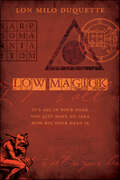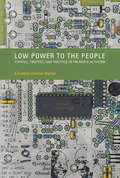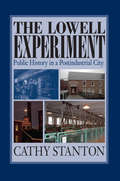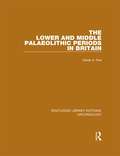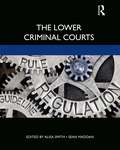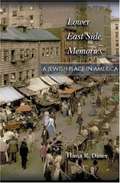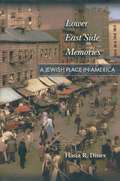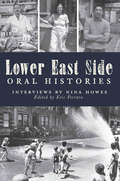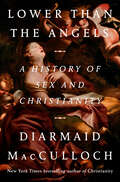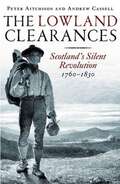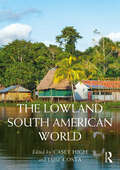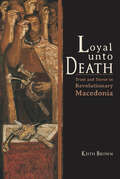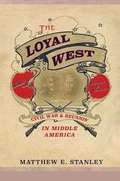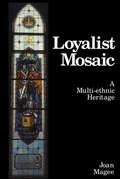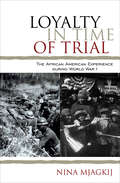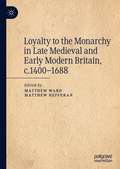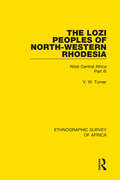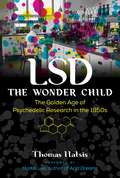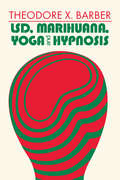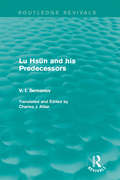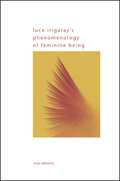- Table View
- List View
Low Magick: It's All In Your Head ... You Just Have No Idea How Big Your Head Is
by Lon Milo DuQuetteTake a fascinating journey into the life of one of the most respected, sought-after, and renowned magicians alive today: Lon Milo DuQuette. In this follow-up to his popular autobiography, My Life with the Spirits, DuQuette tells how a friend was cursed by a well-known foreign filmmaker and how they removed that curse with a little help from Shakespeare. He explains how, as a six-year-old, he used the Law of Attraction to get a date with Linda Kaufman, the most beautiful girl in first-grade. DuQuette also reveals the ins and outs of working with demons and provides a compelling account of performing an exorcism at a private Catholic high school.As entertaining as they are informative, the true stories in this memoir contain authentic magical theory and invaluable technical information.
Low Power to the People: Pirates, Protest, and Politics in FM Radio Activism (Inside Technology)
by Christina Dunbar-HesterAn examination of how activists combine political advocacy and technical practice in their promotion of the emancipatory potential of local low-power FM radio.The United States ushered in a new era of small-scale broadcasting in 2000 when it began issuing low-power FM (LPFM) licenses for noncommercial radio stations around the country. Over the next decade, several hundred of these newly created low-wattage stations took to the airwaves. In Low Power to the People, Christina Dunbar-Hester describes the practices of an activist organization focused on LPFM during this era. Despite its origins as a pirate broadcasting collective, the group eventually shifted toward building and expanding regulatory access to new, licensed stations. These radio activists consciously cast radio as an alternative to digital utopianism, promoting an understanding of electronic media that emphasizes the local community rather than a global audience of Internet users.Dunbar-Hester focuses on how these radio activists impute emancipatory politics to the “old” medium of radio technology by promoting the idea that “microradio” broadcasting holds the potential to empower ordinary people at the local community level. The group's methods combine political advocacy with a rare commitment to hands-on technical work with radio hardware, although the activists' hands-on, inclusive ethos was hampered by persistent issues of race, class, and gender.Dunbar-Hester's study of activism around an “old” medium offers broader lessons about how political beliefs are expressed through engagement with specific technologies. It also offers insight into contemporary issues in media policy that is particularly timely as the FCC issues a new round of LPFM licenses.
The Lowell Experiment: Public History in a Postindustrial City
by Cathy StantonIn the early nineteenth century, Lowell, Massachusetts, was widely studied and emulated as a model for capitalist industrial development. One of the first cities in the United States to experience the ravages of deindustrialization, it was also among the first places in the world to turn to its own industrial and ethnic history as a tool for reinventing itself in the emerging postindustrial economy. The Lowell Experiment explores how history and culture have been used to remake Lowell and how historians have played a crucial yet ambiguous role in that process. The book focuses on Lowell National Historical Park, the flagship project of Lowell's new cultural economy. When it was created in 1978, the park broke new ground with its sweeping reinterpretations of labor, immigrant, and women's history. It served as a test site for the ideas of practitioners in the new field of public history--a field that links the work of professionally trained historians with many different kinds of projects in the public realm. The Lowell Experiment takes an anthropological approach to public history in Lowell, showing it as a complex cultural performance shaped by local memory, the imperatives of economic redevelopment, and tourist rituals--all serving to locate the park's audiences and workers more securely within a changing and uncertain new economy characterized by growing inequalities and new exclusions. The paradoxical dual role of Lowell's public historians as both interpreters of and contributors to that new economy raises important questions about the challenges and limitations facing academically trained scholars in contemporary American culture. As a long-standing and well-known example of "culture-led re-development," Lowell offers an outstanding site for exploring questions of concern to those in the fields of public and urban history, urban planning, and tourism studies.
The Lower and Middle Palaeolithic Periods in Britain (Routledge Library Editions: Archaeology)
by Derek A. RoeThis book deals with the earliest period of human settlement in Britain, proposing a series of archaeological stages for the Lower and Middle Palaeolithic periods. An introduction on the problems and methods of studying the Palaeolithic and Pleistocene periods leads into the technical argument, a sequence of development derived from evidence of stone artefacts and other signs of human activity at stratified sites in south-east England. Materials from all occupied parts of Britain are related to this basic sequence and, stressing that Britain lay on the edge of the Palaeolithic world, the author also brings in essential evidence from Europe and farther afield. The final chapter suggests the probable way of life of human groups in this period. This broad survey synthesises material from widely scattered sources including museums from all over Britain and has an extensive bibliography. Originally published in 1981.
The Lower Criminal Courts
by Alisa Smith Sean MaddanThis book explores misdemeanor courts in the United States by focusing on the processing of misdemeanor crimes and the resultant consequences of conviction, such as loss of employment and housing, the imposition of significant fines, and loss of liberty—all amounting to the criminalization of poverty that happens in many U.S. misdemeanor courts. A major concern is the lack of due process employed in lower courts. Although the seminal case of Gideon v. Wainwright required the appointment of counsel to individuals too poor to hire counsel in felony cases, it was not until 1967, when the President’s Commission on Law Enforcement and Administration of Justice found a crisis in the lower courts, that the Supreme Court extended the right to counsel to some (though not all) prosecutions of misdemeanor offenses. The first step to improving our understanding of the lower courts is a concerted effort by scholars to focus on the processing and outcomes of misdemeanor cases. This collection begins to fill the void by providing a comprehensive review of the scholarly work on the lower courts in the United States. Collecting analysis from key academics engaged in work in this area today, the book reviews the varying specialized lower criminal courts, including specialty courts that have emerged in just the last couple of decades, along with discussions of the history, legal challenges, operation, primary actors (judges, prosecutors, defense counsel, and defendants), and current research on these courts. The book explores the profound consequences misdemeanor processing has for defendants and discusses the future of the lower criminal courts and offers best practices to improve them. The Lower Criminal Courts is essential for scholars and undergraduate and graduate students in criminology, sociology, justice studies, pre-law/legal studies, political science, and social work, and it is also useful as a resource providing legal practitioners with important information, highlighting the significance of consequences of misdemeanor arrests, detentions, and adjudications.
Lower East Side Memories: A Jewish Place In America
by Hasia R. DinerManhattan's Lower East Side stands for Jewish experience in America. With the possible exception of African-Americans and Harlem, no ethnic group has been so thoroughly understood and imagined through a particular chunk of space. Despite the fact that most American Jews have never set foot there--and many come from families that did not immigrate through New York much less reside on Hester or Delancey Street--the Lower East Side is firm in their collective memory. Whether they have been there or not, people reminisce about the Lower East Side as the place where life pulsated, bread tasted better, relationships were richer, tradition thrived, and passions flared. This was not always so. During the years now fondly recalled (1880-1930), the neighborhood was only occasionally called the Lower East Side. Though largely populated by Jews from Eastern Europe, it was not ethnically or even religiously homogenous. The tenements, grinding poverty, sweatshops, and packs of roaming children were considered the stuff of social work, not nostalgia and romance. To learn when and why this dark warren of pushcart-lined streets became an icon, Hasia Diner follows a wide trail of high and popular culture. She examines children's stories, novels, movies, museum exhibits, television shows, summer-camp reenactments, walking tours, consumer catalogues, and photos hung on deli walls far from Manhattan. Diner finds that it was after World War II when the Lower East Side was enshrined as the place through which Jews passed from European oppression to the promised land of America. The space became sacred at a time when Jews were simultaneously absorbing the enormity of the Holocaust and finding acceptance and opportunity in an increasingly liberal United States. Particularly after 1960, the Lower East Side gave often secularized and suburban Jews a biblical, yet distinctly American story about who they were and how they got here. Displaying the author's own fondness for the Lower East Side of story books, combined with a commitment to historical truth, Lower East Side Memories is an insightful account of one of our most famous neighborhoods and its power to shape identity.
Lower East Side Memories: A Jewish Place in America
by Hasia R. DinerManhattan's Lower East Side stands for Jewish experience in America. With the possible exception of African-Americans and Harlem, no ethnic group has been so thoroughly understood and imagined through a particular chunk of space. Despite the fact that most American Jews have never set foot there--and many come from families that did not immigrate through New York much less reside on Hester or Delancey Street--the Lower East Side is firm in their collective memory. Whether they have been there or not, people reminisce about the Lower East Side as the place where life pulsated, bread tasted better, relationships were richer, tradition thrived, and passions flared. This was not always so. During the years now fondly recalled (1880-1930), the neighborhood was only occasionally called the Lower East Side. Though largely populated by Jews from Eastern Europe, it was not ethnically or even religiously homogenous. The tenements, grinding poverty, sweatshops, and packs of roaming children were considered the stuff of social work, not nostalgia and romance. To learn when and why this dark warren of pushcart-lined streets became an icon, Hasia Diner follows a wide trail of high and popular culture. She examines children's stories, novels, movies, museum exhibits, television shows, summer-camp reenactments, walking tours, consumer catalogues, and photos hung on deli walls far from Manhattan. Diner finds that it was after World War II when the Lower East Side was enshrined as the place through which Jews passed from European oppression to the promised land of America. The space became sacred at a time when Jews were simultaneously absorbing the enormity of the Holocaust and finding acceptance and opportunity in an increasingly liberal United States. Particularly after 1960, the Lower East Side gave often secularized and suburban Jews a biblical, yet distinctly American story about who they were and how they got here. Displaying the author's own fondness for the Lower East Side of story books, combined with a commitment to historical truth, Lower East Side Memories is an insightful account of one of our most famous neighborhoods and its power to shape identity.
Lower East Side Oral Histories: Interviews by Nina Howes
by Eric Ferrara and Nina HowesA collection of personal memories and insights from 25 longtime residents of this storied and ever-changing NYC neighborhood. The Lower East Side is one of Manhattan&’s most vibrant neighborhoods. For centuries, it has been home to hundreds of enclaves of immigrants from every part of the world. As they became New Yorkers, the neighborhood has in turn become infused with their cultures, foods, traditions, and personalities. In this book, local historians Eric Ferrara and Nina Howes document the stories and remembrances of twenty-five Lower East Side residents who helped make it what it is today. From childhood memories with family (but without running water) to observations of the constantly changing city, Lower East Side Oral Histories reveals this larger-than-life corner of New York through the eyes and voices of the people who lived there.
Lower than the Angels: A History of Sex and Christianity
by Diarmaid MacCulloch"An epic tale, and MacCulloch is an undaunted guide.&”—New York Review of Books A groundbreaking history of sexual emotion, sexual activity, gender relations, marriage and the family--and how Christianity has interacted with this panorama of human concernsFew matters produce more public interest and public anxiety than sex and religion. Much of the political contention and division in societies across the world centres on sexual topics, and one-third of the global population is Christian in background or outlook. The issue goes to the heart of present-day religion.This book seeks to calm fears and encourage understanding through telling a three-thousand-year-long tale of Christians encountering sex, gender, and the family. The message of Lower than the Angels is simple, necessary and timely: to pay attention to the complexity and contradictions in the history of Christianity. The reader can decide from the story told here whether there is a single Christian theology of sex, or many contending voices in a symphony that is not at all complete. Oxford&’s Emeritus Professor of the History of the Church introduces an epic of ordinary and extraordinary Christians trying to make sense of themselves and of humanity&’s deepest desires, fears and hopes.
The Lowland Clearances: Scotland's Silent Revolution 1760–1830
by Peter Aitchison Andrew CassellThe forced removal of family farmers across the Scottish Lowlands in the 18th and 19th centuries is chronicled in this enlightening social history. The Scottish Agricultural Revolution came at great cost to the poor cottars and tenant farmers who were driven from their homes to make way for livestock and crops. The process of forced evictions through the Highlands known as the Highland Clearances is a well-documented episode of Scottish history. But the process actually began in the Scottish Lowlands nearly a century before—in the so-called Age of Improvement. Though largely overlook by historians, the Lowland Clearances undeniably shaped the Scottish landscape as it is today. They swept aside a traditional way of life, causing immense upheaval for rural dwellers, many of whom moved to the new towns and cities or left the country entirely. With pioneering research, historian Peter Aitchison tells the story of the Lowland Clearances, establishing them as a significant aspect of the Clearances that changed the face of Scotland forever.
Lowland Grassland and Heathland Habitats (Habitat Guides)
by Elizabeth PriceGrasslands are everywhere: agricultural land, playing fields and road verges; but while species-poor, intensively managed grasslands are widespread, colourful semi-natural grasslands and heathlands, buzzing with life, are scarce. These semi-natural habitats are ancient, cultural landscapes, which are of considerable, if not international importance for biodiversity. However, despite targets for the conservation and restoration of these valuable grasslands and heathlands, these habitats continue to decline before our eyes. Lowland Grassland and Heathland Habitats contrasts the uniformity of intensively managed grassland with the diversity of traditionally managed grasslands and heathlands. It examines topics of concern to the ecologist or habitat manager such as causes of the loss and deterioration of these habitats, including inappropriate management, eutrophication and climate change. It then evaluates opportunities for positive change, such as conservation, restoration and creation. A series of case-studies illustrates the pressures on some lowland grassland and heathland habitat types and looks at ways to enhance them for biodiversity. This habitat guide features illustrated species boxes of typical plants and animals, as well as a full species list, a series of projects on the ecology of grassland and heathland species, a colour plate section, up-to-date references and information, and a full glossary. It will provide students and environmentalists with a deeper understanding of the nature and importance of lowland grasslands and heathlands.
The Lowland South American World (Routledge Worlds)
by Casey High Luiz CostaThe Lowland South American World showcases cutting-edge research on the anthropology of Lowland South America, providing both an in-depth knowledge of Lowland South American life ways and engaging readers in urgent social, environmental, and political issues in the contemporary world.Covering the vast expanse of a region that includes all of South America except for the Andes, its 40 chapters engage with questions of what “Lowland South America” means as a geographical designation, both in studies of Indigenous Amazonian peoples and other lowland areas of the continent. They emphasize the multiple ways that local practices and cosmologies challenge conventional Western ideas about nature, culture, personhood, sociality, community, and Indigenous people.Some of the region’s well-known contributions to anthropology, such as animism, perspectivism, and novel approaches to the body are updated here with new ethnography and in light of the varying political situations in which the region’s peoples find themselves. With contributions by authors from 15 different countries, including a number of Indigenous anthropologists and activists, this book will set the agenda for future research in the continent.The Lowland South American World is a valuable resource for scholars and students of anthropology, Latin American studies and Indigenous studies, as well as history, geography and other social sciences.
Lowly Origin: Where, When, and Why Our Ancestors First Stood Up
by Jonathan KingdonOur ability to walk on two legs is not only a characteristic human trait but one of the things that made us human in the first place. Once our ancestors could walk on two legs, they began to do many of the things that apes cannot do: cross wide open spaces, manipulate complex tools, communicate with new signal systems, and light fires. Titled after the last two words of Darwin's Descent of Man and written by a leading scholar of human evolution, Lowly Origin is the first book to explain the sources and consequences of bipedalism to a broad audience. Along the way, it accounts for recent fossil discoveries that show us a still incomplete but much bushier family tree than most of us learned about in school. Jonathan Kingdon uses the very latest findings from ecology, biogeography, and paleontology to build a new and up-to-date account of how four-legged apes became two-legged hominins. He describes what it took to get up onto two legs as well as the protracted consequences of that step--some of which led straight to modern humans and others to very different bipeds. This allows him to make sense of recently unearthed evidence suggesting that no fewer than twenty species of humans and hominins have lived and become extinct. Following the evolution of two-legged creatures from our earliest lowly forebears to the present, Kingdon concludes with future options for the last surviving biped. A major new narrative of human evolution, Lowly Origin is the best available account of what it meant--and what it means--to walk on two feet.
Lowrider Space: Aesthetics and Politics of Mexican American Custom Cars
by Ben ChappellAren't lowriders always gangbangers? And, don't they always hold high status in their neighborhoods? Contrary to both stereotypes, the people who build and drive lowrider cars perform diverse roles while mobilizing a distinctive aesthetic that is sometimes an act of resistance and sometimes of belonging. A fresh application of critical ethnographic methods, Lowrider Space looks beyond media portrayals, high-profile show cars, and famous cruising scenes to bring readers a realistic tour of the "ordinary" lowriders who turn streetscapes into stages on which dynamic identities can be performed. Drawing on firsthand participation in everyday practices of car clubs and cruising in Austin, Texas, Ben Chappell challenges histories of erasure, containment, and class immobility to emphasize the politics of presence evidenced in lowrider custom car style. Sketching out a partially personal map of the lowrider presence in Texas's capital city, Chappell also explores the interior and exterior adornment of the cars (including the use of images of women's bodies) and the intersecting production of personal and social space. As he moves through a second-hand economy to procure parts necessary for his own lowrider vehicle, on "service sector" wages, themes of materiality and physical labor intersect with questions of identity, ultimately demonstrating how spaces get made in the process of customizing one's self.
Loyal Unto Death: Trust and Terror in Revolutionary Macedonia (New Anthropologies of Europe)
by Keith Brown“The story of the Macedonian Revolutionary Organization (MRO) from its rise until the Illinden Uprising of 1903 . . . a fascinating account.” —PoLARThe underground Macedonian Revolutionary Organization recruited and mobilized over 20,000 supporters to take up arms against the Ottoman Empire between 1893 and 1903. Challenging conventional wisdom about the role of ethnic and national identity in Balkan history, Keith Brown focuses on social and cultural mechanisms of loyalty to describe the circuits of trust and terror—webs of secret communications and bonds of solidarity—that linked migrant workers, remote villagers, and their leaders in common cause. Loyalties were covertly created and maintained through acts of oath-taking, record-keeping, arms-trading, and in the use and management of deadly violence.“This book is, to my mind, exactly the kind of work that needs to be done in order to understand civil wars, insurgencies, nationalism, and rebellions, and to get away from what the author rightfully critiques as ‘pidgin social science.’” —Chip Gagnon, Ithaca College“An innovative work that should inspire debate.” —Slavic Review“A subtle and compelling account of revolutionary insurgency in turn-of-the-century Macedonia. His analytical focus on loyalties, rather than identities, goes beyond critiques of nationalism in enabling powerful new understandings of the region’s histories and its continuing social dynamics.” —Jane K. Cowan, University of Sussex
The Loyal West: Civil War and Reunion in Middle America
by Matthew E. StanleyA free region deeply influenced by southern mores, the Lower Middle West represented a true cultural and political median in Civil War-era America. Here grew a Unionism steeped in the mythology of the Loyal West--a myth rooted in regional and racial animosities and the belief that westerners had won the war. Matthew E. Stanley's intimate study explores the Civil War, Reconstruction, and sectional reunion in this bellwether region. Using the lives of area soldiers and officers as a lens, Stanley reveals a place and a strain of collective memory that was anti-rebel, anti-eastern, and anti-black in its attitudes--one that came to be at the forefront of the northern retreat from Reconstruction and toward white reunion. The Lower Middle West's embrace of black exclusion laws, origination of the Copperhead movement, backlash against liberalizing war measures, and rejection of Reconstruction were all pivotal to broader American politics. And the region's legacies of white supremacy--from racialized labor violence to sundown towns to lynching--found malignant expression nationwide, intersecting with how Loyal Westerners remembered the war.
Loyalist Mosaic: A Multi-Ethnic Heritage
by Joan MageeLoyalist Mosaic highlights the ethnic diversity among the Loyalist settlers to Canada by exploring the experiences of 11 extraordinary individuals.
Loyalty in Time of Trial: The African American Experience During World War I (The African American Experience Series)
by Nina MjagkijThe little-known history of black soldiers and defense workers in the First World War, and what happened afterward: &“Highly recommended.&” —Choice In one of the few book-length treatments of the subject, historian Nina Mjagkij conveys the full range of the African American experience during the &“Great War.&” Prior to World War I, most African Americans did not challenge the racial status quo. But nearly 370,000 black soldiers served in the military during the war, and some 400,000 black civilians migrated from the rural South to the urban North for defense jobs. Following the war, emboldened by their military service and their support of the war on the home front, African Americans were determined to fight for equality—but struggled in the face of indifference and hostility in spite of their combat-veteran status. America would soon be forced to confront the impact of segregation and racism—beginning a long, dramatic reckoning that continues over a century later. &“Painstakingly describes the frustration, sometimes anger, and frequent courage demonstrated by southern and northern African Americans in their attempts to include themselves in the national crusade of making the world safe for democracy . . . one of the most comprehensive treatments of the race issue in the early twentieth century that this reader has seen.&” —Journal of Southern History
Loyalty to the Monarchy in Late Medieval and Early Modern Britain, c.1400-1688
by Matthew Ward Matthew HefferanThis book explores the place of loyalty in the relationship between the monarchy and their subjects in late medieval and early modern Britain. It focuses on a period in which political and religious upheaval tested the bonds of loyalty between ruler and ruled. The era also witnessed changes in how loyalty was developed and expressed. The first section focuses on royal propaganda and expressions of loyalty from the gentry and nobility under the Yorkist and early Tudor monarchs, as well as the fifteenth-century Scottish monarchy. The chapters illustrate late-medieval conceptions of loyalty, exploring how they manifested themselves and how they persisted and developed into early modernity. Loyalty to the later Tudors and early Stuarts is scrutinised in the second section, gauging the growing level of dissent in the build-up to the British Civil Wars of the seventeenth century. The final section dissects the role that the concept of loyalty played during and after the Civil Wars, looking at how divergent groups navigated this turbulent period and examining the ways in which loyalty could be used as a means of surviving the upheaval.
The Lozi Peoples of North-Western Rhodesia: West Central Africa Part III
by V. W. TurnerRoutledge is proud to be re-issuing this landmark series in association with the International African Institute. The series, published between 1950 and 1977, brings together a wealth of previously un-co-ordinated material on the ethnic groupings and social conditions of African peoples. Concise, critical and (for its time) accurate, the Ethnographic Survey contains sections as follows: Physical Environment Linguistic Data Demography History & Traditions of Origin Nomenclature Grouping Cultural Features: Religion, Witchcraft, Birth, Initiation, Burial Social & Political Organization: Kinship, Marriage, Inheritance, Slavery, Land Tenure, Warfare & Justice Economy & Trade Domestic Architecture Each of the 50 volumes will be available to buy individually, and these are organized into regional sub-groups: East Central Africa, North-Eastern Africa, Southern Africa, West Central Africa, Western Africa, and Central Africa Belgian Congo. The volumes are supplemented with maps, available to view on routledge.com or available as a pdf from the publishers.
LSD — The Wonder Child: The Golden Age of Psychedelic Research in the 1950s
by Thomas Hatsis• Explores the different groups--from research labs to the military--who were seeking how best to utilize LSD and other promising psychedelics like mescaline • Reintroduces forgotten scientists like Robert Hyde and Rosalind Heywood • Looks at the CIA&’s notorious top-secret mind-control program MKUltra • Reveals how intellectuals, philosophers, artists, and mystics of the 1950s used LSD to bring ancient rites into the modern ageExploring the initial stages of psychedelic study in Europe and America, Thomas Hatsis offers a full history of the psychedelic-fueled revolution in healing and consciousness expansion that blossomed in the 1950s--the first &“golden age&” of psychedelic research. Revealing LSD as a &“wonder child&” rather than Albert Hofmann&’s infamous &“problem child,&” the author focuses on the extensive studies with LSD that took place in the &’50s. He explores the different groups--from research labs to the military to bohemian art circles--who were seeking how best to utilize LSD and other promising psychedelics like mescaline. Sharing the details of many primary source medical reports, the author examines how doctors saw LSD as a tool to gain access to the minds of schizophrenics and thus better understand the causes of mental illness.The author also looks at how the CIA believed LSD could be turned into a powerful mind-control weapon, including a full account of the notorious top-secret program MKUltra. Reintroducing forgotten scientists like Robert Hyde, the first American to take LSD, and parapsychologist Rosalind Heywood, who believed LSD and mescaline opened doors to mystical and psychic abilities, the author also discusses how the infl uences of Central American mushroom ceremonies and peyote rites crossbred with experimental Western mysticism during the 1950s, turning LSD from a possible madness mimicker or mind weapon into a sacramental medicine. Finally, he explores how philosophers, parapsychologists, and mystics sought to use LSD to usher in a new age of human awareness.
LSD, Marihuana, Yoga, and Hypnosis
by Theodore X. BarberThe practice of yoga, hypnosis, and the use of psychedelic drugs to alter psychological and physiological states is not unknown to the study of psychology. They have been called "soft" studies and labeled unimportant. This is mostly because they are difficult to study and understand, often focusing on unobservable internal states such as altered states of consciousness, Samadhi, or hypnotic states. This book, in its approach to thinking about this topic and method for analysis, focuses only on phenomena that can be observed, such as behavioral changes.By centering on only those aspects of the psychological and physiological effects of yoga, hypnosis, and psychedelic drugs which can be measured and analyzed using this new method, Barber distinguishes this book from others in the field. He asks what overt behaviors and verbal reports are clearly observable when psychedelic drugs are taken, yoga is practiced, or hypnotic-induction procedures are administered. Instead of treating the phenomena traditionally associated with psychedelic drugs, yoga, or hypnosis as undifferentiated conglomerates, an attempt will be made to set apart and treat separately each of the many phenomena associated with each of these areas of inquiry.This book does not set out to simply demonstrate the importance of psychedelics, yoga, and hypnosis, or to present substantive material pertaining to these topics. It also treats each topic as continuous with other known psychological phenomena and as an important piece to the puzzle of social psychology. It differs from most previous treatises in that it does not assume that psychedelics, yoga, and hypnosis can bring out unused mental or physical capacities in man, heighten awareness or give rise to enhanced creativity, or produce altered states of consciousness, suspension of conventional reality-orientation, changes in body-image, or changes in perception.
Lu Hsün and his Predecessors (Routledge Revivals)
by V. I. SemanovOriginally published in 1980, Alber’s translation of Semanov’s study aimed to contribute to the studies of Chinese literature and the knowledge of Lu Hsün’s work to an English-speaking reader. Lu Hsün was an influential democrat and humanist in early twentieth Century China and his work had a great influence on literature in China. Semanov therefore attempted to place his life and work in the context of his literary predecessors as well as commenting on his world view, his teaching and place in history. This title will be of interest to students of Asian studies and Literature.
The Lubicon Lake Nation
by Dawn Martin-HillMany argue that the Lubicon, a small Cree nation in northern Alberta, have been denied their unalienable right to self-determination by the Canadian government. In a country such as Canada, some see the plight of the Lubicon people as an enduring reminder that certain democratic principles and basic freedoms are still kept from minorities, indigenous groups in particular.The Lubicon Lake Nation strives, through a critique of historically-constructed colonial images, to analyze the Canadian government's actions vis-à-vis the rights of the Lubicon people. Dawn Martin-Hill illustrates the power of indigenous knowledge by contrasting the words, ideas, and self-conceptualizations of the Lubicon with official versions of Lubicon history as documented by the state. In doing so, she offers a genuine sense of the gravity of their lived experiences. By giving voice to the Lubicon, this study seeks to develop an exclusively indigenist framework in which the circumstances facing the people can be described and analyzed more accurately than they can using popular conceptions of native rights as put forth by the government.The Lubicon Lake Nation is a story of one culture and the pursuit of indigenous rights in Canada as told from the perspective of those who know the situation best, the Lubicon themselves.
Luce Irigaray's Phenomenology of Feminine Being (SUNY series in Gender Theory)
by Virpi LehtinenThe reception of Luce Irigaray's ideas about feminine identity has centered largely on questions of essentialism, whether criticizing this as a destructive flaw or interpreting it in strategic or pragmatic terms. Staking out an alternative approach, Virpi Lehtinen finds in the phenomenology of Husserl and Merleau-Ponty a framework for what she characterizes as dynamic essentialism, which seeks to account for the complex networks of lived experience: embodied, affective, and spiritual relations to oneself, to others, and to the world. Rather than prescribing one norm to which all women should conform, Lehtinen argues, Irigaray's work exemplifies how each individual woman in her own way contributes to a norm of femininity that is both unique and singular but also connected to the existential styles of past, present, and future others.
